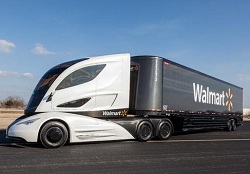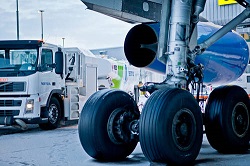 It’s a pretty cool looking design (although I’m not sure how my friends in the trucking industry would take to being inches from the roadway). And what makes it even cooler is the fact that a new concept semi from Walmart would be able to run on alternative fuels, including biodiesel or natural gas. This blog post from the company story says the new truck debuted at Walmart’s Global Sustainability Milestone Meeting.
It’s a pretty cool looking design (although I’m not sure how my friends in the trucking industry would take to being inches from the roadway). And what makes it even cooler is the fact that a new concept semi from Walmart would be able to run on alternative fuels, including biodiesel or natural gas. This blog post from the company story says the new truck debuted at Walmart’s Global Sustainability Milestone Meeting.
We’re just beginning formal testing, but this Walmart Advanced Vehicle Experience (WAVE) concept truck will be 20 percent more aerodynamic than our current trucks and have a micro-turbine hybrid powertrain that can run on diesel, natural gas, biodiesel and probably other fuels still to be developed. It may never make it to the road, but it will allow us to test new technologies and new approaches. I share it because it gives you a sense of how sustainability is helping us see things in new ways.
WAVE was just one of the innovations we discussed at our Sustainability Milestone Meeting on Monday. We also talked about new ideas around less photogenic topics like air filters, buttons, and even landfills. By seeing through the lens of sustainability, we are accelerating the pace of innovation across our business.
With about 7,000 vehicles in its truck fleet, let’s hope Walmart keeps riding low with biodiesel and natural gas.









